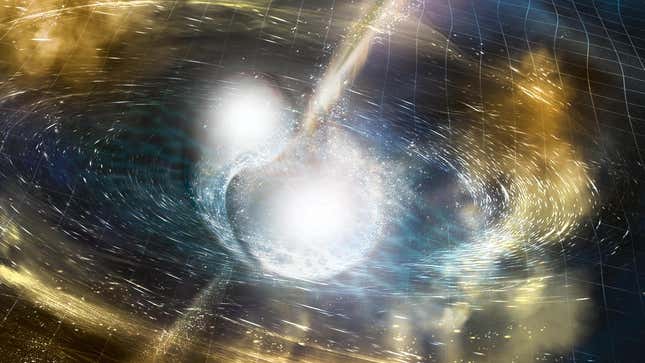
After a prolonged absence from the gravitational-wave-detection scene, the massive LIGO project is back up and running.
The Laser Interferometer Gravitational-Wave Observatory (LIGO) works in conjunction with the Virgo detector in Italy and the KAGRA detector in Japan to suss out gravitational waves—perturbations in the fabric of spacetime caused by interactions of massive objects.
The collaboration made monumental news in 2016 when it first made a gravitational wave detection, confirming a phenomenon predicted by physicist Albert Einstein over a century ago. The basic idea is that objects with terrific gravitational fields, generally the densest objects in the universe, such as black holes and neutron stars, cause ripples in spacetime when they form, interact, and merge.
These gravitational waves pulsate outwards through the universe, and minuscule differences in measurements taken by LIGO reveal how the waves stretched spacetime. In 2021, quantum physicists supercooled LIGO’s mirrors to near-absolute zero to see how still they could make the ultra-sensitive detector.
Since LIGO’s first detection, sniffing out gravitational waves has become routine for the detector. But now the completion of a $35 million upgrade to the detectors in Washington and Louisiana is expected to jump the number of detections from about one per week to one every couple of days, according to Nature.
A significant part of the upgrade was the construction of additional vacuum pipes with mirrors at their ends, which will reduce the amount of noise the scientists have to sift through in their search. The pipes will also reduce the jitter of the mirrors at low frequencies; when trying to discern the slightest movements of objects on Earth, jitter is something you’d like to avoid.
The Virgo detector has also undergone an upgrade, to the tune of $9 million, that includes new vacuum pipes, but technical issues have delayed its restart. Gianluca Gemme, a physicist at Italy’s National Institute of Nuclear Physics and Virgo spokesperson, told Nature that “our expectation is we’ll be able to restart by the end of summer or early autumn.”
Though Virgo is delayed, Japan’s KAGRA detector restarted on May 24. KAGRA will join in with LIGO’s new experimental run before undergoing further commissioning next month. LIGO’s latest observation run will last for 20 months.
Later this decade, LIGO-Virgo-KAGRA is expected to be joined by LIGO-India, which was built in the image of the U.S. observatory. And in fact, some of LIGO-India will be constructed with spare parts from the original LIGO, according to Nature.
With more detectors around the world, scientists can fine-tune their results by effectively making distant points on our planet’s interferometers. Future gravitational wave detections will also likely benefit from artificial intelligence’s increasingly robust presence in astrophysics.
Some noise in Earth-based observatories is inescapable, however, so the European Space Agency and NASA hope to launch a space-based gravitational wave observatory in the future. Named LISA, this observatory would involve precisely coordinated spacecraft orbiting in a Kubrickian dance to make even more precise detections of the universe’s most violent forces.
For now, we wait with bated breath to see how the new-and-improved LIGO performs.
More: Astronomers Detected Gravitational Waves. Now They Want to See the Cosmic Ocean